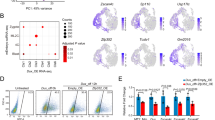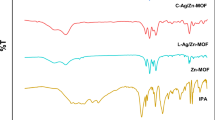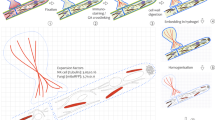Abstract
THE spatial pattern of cellular differentiation in the chick limb can be viewed in terms of positional information. For the antero–posterior axis of the wing, positional information seems to be specified by reference to a group of cells at the posterior margin of the limb bud—the zone of polarising activity (ZPA)1–3. By grafting an additional ZPA to different positions along the antero–posterior axis, we found that structures form according to their distance from the nearest ZPA. For instance, digit 4 forms nearest to the ZPA, then digit 3, then digit 2. We suggested that cells might measure distance by means of a diffusible morphogen produced by the ZPA, the concentration of which falls as distance from the ZPA increases. The responding cells are able to interpret the concentration of the morphogen, and so behave according to their position. If it is the concentration of morphogen that specifies which digit shall form, then lowering the concentration of morphogen adjacent to the ZPA should result in digit 3 being formed next to the ZPA instead of digit 4. If the concentration is lowered still further, digit 2, and finally no additional digit should form next to the ZPA. We have obtained such an attenuation of positional signalling by treating the ZPA with increasing doses of γ radiation.
Similar content being viewed by others
Article PDF
References
Saunders, J. W. & Gasseling, M. T. in Epithelial-Mesenchymal Interactions (ed. Fleischmayer, R. & Billingham, R. F.) 78–97 (Williams and Wilkins, Baltimore, 1968).
Tickle, C., Summerbell, D. & Wolpert, L. Nature 254, 199–202 (1975).
Summerbell, D. & Tickle, C. in Vertebrate Limb and Somite Morphogenesis (ed. Ede, D. A. Hinchliffe, J. R. & Balls, M.) 41–53 (Cambridge University Press, Cambridge and London, 1977).
French, V., Bryant, P. J. & Bryant, S. V. Science 193, 969–981 (1976).
Adler, P. N. & Bryant, P. J. Devl Biol. 60, 298–304 (1977).
Hicklin, J. & Wolpert, L. J. Embryol. exp. Morph. 30, 741–752 (1973).
MacCabe, A. B., Gasseling, M. T. & Saunders, J. W. Jr Mech. Ageing Dev. 2, 1–12 (1973).
Fallen, J. F. & Crosby, G. M. J. exp. Zool. 193, 449–455 (1975).
Author information
Authors and Affiliations
Rights and permissions
About this article
Cite this article
SMITH, J., TICKLE, C. & WOLPERT, L. Attenuation of positional signalling in the chick limb by high doses of γ-radiation. Nature 272, 612–613 (1978). https://doi.org/10.1038/272612a0
Received:
Accepted:
Issue date:
DOI: https://doi.org/10.1038/272612a0
This article is cited by
-
Dorsalizing signal Wnt-7a required for normal polarity of D–V and A–P axes of mouse limb
Nature (1995)
-
Local application of retinoic acid to the limb bond mimics the action of the polarizing region
Nature (1982)
-
The number of polarizing region cells required to specify additional digits in the developing chick wing
Nature (1981)
-
Transition from polar to duplicate patterns
Journal of Mathematical Biology (1980)



